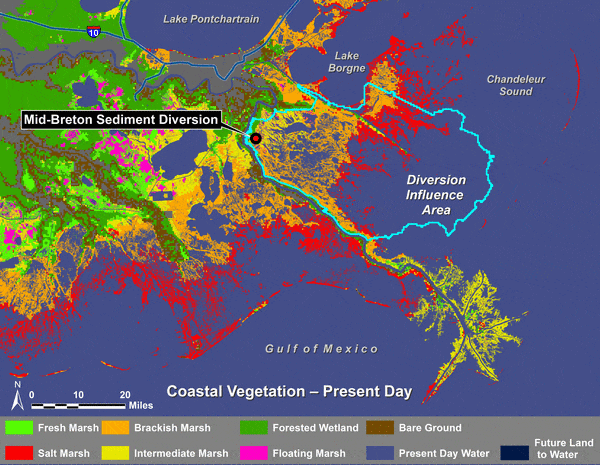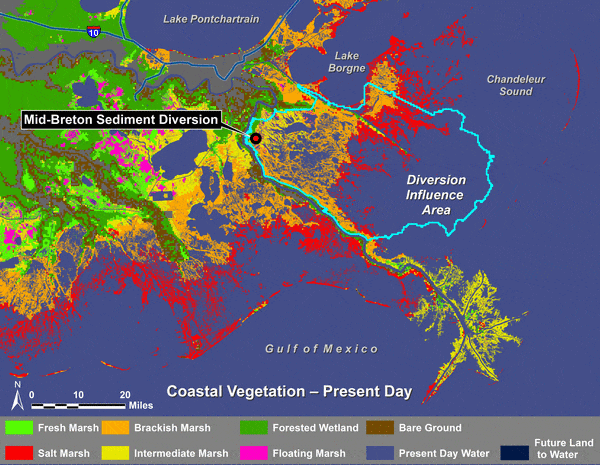Mid-Breton Sediment Diversion: What It Is and Why It’s Needed
To restore Louisiana’s coast, we need a suite of large-scale restoration projects across the coast working together to deliver maximum benefits and reduce land loss, restore ecosystems and maintain habitat. In this “Restoration Project Highlights” series, we’ll be taking a deeper look at specific projects from our list of Priority Projects, focusing on why they’re important, the local impacts and local perspectives.
A local’s perspective on the Mid-Breton Sediment Diversion.
Albertine Kimble, Plaquemines Parish Resident
What is the Mid-Breton Sediment Diversion?
The Mid-Breton Sediment Diversion is a key project in the 2017 Coastal Master Plan intended to reduce land loss in the Breton Basin. Sediment diversions use the power of the Mississippi River itself to move sediment and fresh water from the river into nearby basins, mimicking nature’s historic land-building processes. These projects not only build new land but also provide an ongoing source of sand and mud necessary to sustain and increase the health of existing wetlands over time. This proposed diversion will be located on the east bank of the Mississippi River at Wills Point in Plaquemines Parish.

Why does Louisiana need the Mid-Breton Sediment Diversion?
As soon as it begins operating, the Mid-Breton diversion will begin depositing sediment and benefitting marshes that have been sediment-starved since levees were built almost 100 years ago. The diversion will build and maintain almost 16,000 acres of new land in the Breton Basin during its first 50 years of operation.
Mid-Breton will complement other projects in the basin, such as marsh creation and ridge restoration, by helping protect these projects and extending their lifespan. In the recent NRDA Barataria Restoration Plan, the Trustees highlighted the importance of sediment diversions, saying, “Other restoration techniques, such as large marsh creation projects or multiple small-scale sediment diversions, cannot by themselves deliver the same benefits or perform the same functions as an alternative that includes a large-scale sediment diversion.” The addition of sediment and nutrients from the river will gradually increase soil strength, improving the marshes in the basin. These wetlands also provide an important line of defense against storm surge for local communities and the New Orleans metro region.
As land is built, the project will also restore the range of salinity in the estuary, which can be anywhere from very salty to fresh to brackish. These ranges in salinity contribute to the high productivity of habitats for many fish, bird, and marine species which local communities may rely on for their livelihoods. In the long term, the Mid-Breton diversion is an essential component of the 2017 Coastal Master Plan to restore land and increase community resilience in the face of sea level rise, hurricanes, and other environmental challenges.
When will the Mid-Breton Sediment Diversion be constructed?
The Mid-Breton Diversion is part of CPRA’s Mid-Basin Sediment Diversion Program, which includes the larger Mid-Barataria Sediment Diversion. As Mid-Barataria advances through the implementation process ahead of Mid-Breton, it will provide lessons learned for this similar though slightly smaller project.
CPRA has indicated that both of these diversions will move to construction as quickly as possible. In addition, CPRA is conducting engineering and design for Mid-Breton under a contracting arrangement known as Construction Management At Risk (CMAR). CMAR brings the project engineer in contact with the project designer early in the planning process, with a goal of achieving a better project at a lower price tag on a faster timeline. CPRA has already chosen StanTec, an engineering firm with international contacts, and expects Mid-Breton to be ready to construct by 2023.
What does a future without action look like?
What does a future without action look like? |
What does a future with action look like? |
 |
 |
How will the Mid-Breton Sediment Diversion benefit wildlife?
 The land built by the Mid-Breton Sediment Diversion will serve as prime habitat for the King Rail, a bird species that thrives in fresh to brackish marsh. The King Rail is listed as “Climate Endangered” by the National Audubon Society because the loss of plentiful habitat has caused this species to decline and even disappear in some areas. The Mid-Breton Sediment Diversion would rebuild some of this lost habitat and provide a safe haven for this important bird species.
The land built by the Mid-Breton Sediment Diversion will serve as prime habitat for the King Rail, a bird species that thrives in fresh to brackish marsh. The King Rail is listed as “Climate Endangered” by the National Audubon Society because the loss of plentiful habitat has caused this species to decline and even disappear in some areas. The Mid-Breton Sediment Diversion would rebuild some of this lost habitat and provide a safe haven for this important bird species.